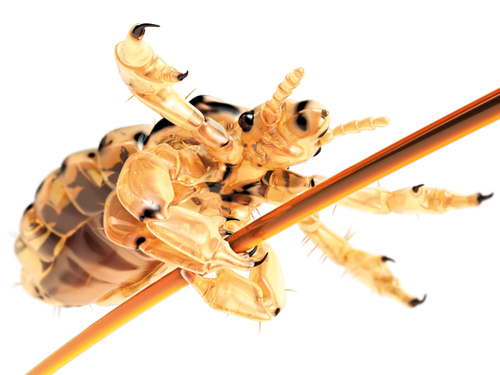School of thought
In OTC
Follow this topic
Bookmark
Record learning outcomes
The new school term can spark a whole host of excitement and dread for children, but also for their parents when it comes to the risk of them picking up bugs of various kinds
With the new school term on the horizon, there are lots of health concerns that are likely to be playing on parents’ minds, from upset stomachs to colds, but perhaps most of all, head lice.

Head lice are extremely common and most children are likely to catch them at some point. Unfortunately, myths about head lice are equally as common, so pharmacy staff should be knowledgeable about how to detect them, which treatments can be recommended and how to prevent re-infection.
It is also important to be able to give parents sound advice that will allay common concerns that lice are the result of dirty hair, bad personal hygiene or a dirty house, as none of these are true.
The facts
Head lice are small wingless insects about the size of a sesame seed. They have hooks on their legs enabling them to cling tightly to hairs and stay close to the scalp, which they feed off.
Lice cannot fly or jump but walk from one head to another. In fact, it takes only 30 seconds for a louse to transfer from one scalp to another.
Female lice live for up to 40 days, during which time they can lay up to 150 eggs. They attach their eggs – known as nits – to hairs close to the scalp surface. The eggs are yellow or brown, and the size of a pinhead. They take seven to 10 days to hatch and the new lice can lay more eggs after around seven days. This means that head lice can proliferate quickly once established.
Head lice can affect anyone, but are:
- Most common in children between the ages of four and 11
- More common in girls than boys
- Most often found at the start of the school year.
Sid Dajani, owner of Wainwrights Chemist in Bishopstoke, says: “We do get a lot of parents coming in to the pharmacy who are really upset by discovering head lice in their children’s hair. There are many myths about head lice. People tell me they have used hairspray, vinegar, olive oil, alcohol, even petrol to try and get rid of them. One customer told me they had consulted Google and used melted butter under a shower cap, which of course didn’t work.”
Sid says parents often feel there is a stigma to their children having head lice. “It is really important to stress that [head lice] can affect anyone with long or short hair, no matter how clean the hair is. There is a really important role here for well-trained pharmacy staff to reassure parents and give good advice.”
Detection
Head lice have to feed on human blood several times a day to survive. Their bites, saliva and faeces often make the scalp itchy, however some people may be unaware they have head lice, as they do not experience the itch or other symptoms. Parents may notice a rash on a child’s head caused by scratching or small black specks like dust on the pillow, which are head lice droppings.
The National Institute for Health and Care Excellence (NICE) says the only way to diagnose head lice is by detection combing – the systematic combing of the hair with a fine-toothed detection comb: “This is the most reliable way to confirm the presence of head lice, and it is much more reliable than visual inspection.”
NICE also states that a live louse must be found to confirm an infection and an itching scalp is not sufficient to diagnose active infection, nor is the presence of louse eggs alone. All members of the household and close contacts should also be checked.
Treatment
There are several methods to treat a head lice infection. Talking through each one is important so that customers can make an informed decision.
-
Mechanical removal
This involves the systematic combing of wet hair with a special fine-toothed detection comb to remove the lice. The comb should be cleaned immediately after each pass through the hair to remove lice and eggs by wiping it on a clean white cloth or paper.
The process must be repeated every few days for two weeks and can take 10-30 minutes depending on the type of hair.
Advantages:
- Resistance is not an issue
- The method is safe
- It is inexpensive and combs can be reused
- Clinical trials have reported cure rates of more than 50 per cent after two weeks.
Disadvantages:
- It is labour intensive, which may be an issue when treating young children or several people at once
- It is ineffective if an unsuitable comb or incorrect method is used.
Joanna Ibarra, programme co-ordinator at Community Hygiene Concern, says customers should be advised to use a lice detection comb as these combs are specially designed with the teeth spaced so that they can remove the smallest louse but still pass easily through the hair.
“If you really wet the hair it takes the moisture right down to the roots and that completely bathes the lice in moisture,” says Joanna. “This makes them motionless; they close down like submarines until they moisture goes away. That gives you the chance to comb them out. If you comb the hair when it is dry the lice simply move around the scalp and you might miss them completely.”
She adds that customers should be advised to apply plenty of conditioner to the hair so the comb can go through more easily.
-
Physical treatments
Products containing dimeticone or isopropyl myristate kill lice through physical action. Dimeticone coats the surfaces of head lice and suffocates them, whereas isopropyl myristate dehydrates head lice by dissolving their external wax coating.
In general, two applications will be needed seven days apart to ensure that the lice that have hatched after the first application are also killed.
Advantages:
- Easy to apply
- Safe to use and have few side effects
- Either odourless or have a faint perfume so are not unpleasant
- Head lice are unlikely to become resistant to them.
Disadvantages:
- Instructions must be followed exactly otherwise the treatment won’t work
- Some variants don’t kill eggs so the treatment must be repeated after a week to kill any lice that have hatched since the first application.
-
Traditional insecticide
The only chemical insecticide currently recommended for treating head lice contains malathion. It works by poisoning the lice.
Advantages:
- There is no evidence of any serious adverse reactions, although the manufacturers say skin irritation can occur.
Disadvantages:
- Resistance to these products has been reported since the mid-1990s
- It has an unpleasant smell.
-
Herbal or alternative treatments
Herbal remedies and essential oil-based treatments such as tea tree oil, eucalyptus oil, and lavender oil are available as potential treatments for head lice but there is little evidence regarding thir effectiveness.

Recommending products
NICE guidance states: “The choice of treatment will depend on the preference of the person and/or their parents/carers after considering the advantages and disadvantages of each treatment, what has been previously tried, and the cost of the treatment.”
Ian Burgess, director of the Medical Entomology Centre, says: “Based on the evidence we have available in the public domain, dimeticone is probably the most effective, with isopropyl myristate being similar in effect. These products incidentally have the largest market share. Pharmacy staff should be aware that there are numerous products on the market in all four treatment groups that claim effectiveness but have no clinical evidence to support those claims so they should be guided by clinical evidence when recommending products.”
NICE guidance also states that only wet combing or dimeticone 4% lotion are recommended as first-line treatment for pregnant or breastfeeding women, children aged six months to two years, and people with asthma or eczema.
Additional advice
As well as discussing treatment options, the following advice can be passed on to customers:
- Once detected head lice should be treated immediately
- Children with a head lice infection can still attend school
- There is no need to wash clothing or bedding
- Read the instructions carefully, use the treatment correctly and treat all affected household members at the same time
- When using dimeticone-containing products, the hair should be kept away from naked flames, including cigarettes, and other sources of ignition during treatment. Although not flammable, dimeticone is not water based and will not prevent hair from burning. Care should be taken if the product is spilled as it can make surfaces slippery.
Sid says counter staff should advise customers to buy enough product to complete a treatment course. In general, a small bottle of treatment is sufficient for treating short or shoulder-length hair, but a larger bottle or two small bottles will be needed for longer, thicker hair. If children are prone to repeated infections then he recommends having a spare bottle of treatment so they can be treated promptly and prevent the spread.
If treatment doesn’t work, the British Association of Dermatologists (BAD) says:
- The head lice diagnosis may have been incorrect
- The treatment instructions may not have been followed correctly
- The lice may have been resistant to the treatment
- The child may have picked up a new infection immediately after the treatment finished
- Repeat the treatment or try a different one.
Prevention
According to NICE, there is no evidence that products marketed as head lice repellents work, nor is there any evidence that treatments used prophylactically (for prevention) are effective. It advises that head lice treatments should not be used repeatedly in the absence of live lice. It is a parent’s decision whether to try preventative products.
The BAD recommends regular weekly detection combing. “Do not use chemicals regularly in an attempt to prevent an infestation occurring; this simply encourages the emergence of resistant strains of lice,” it warns.
Head lice can affect anyone with long or short hair, no matter how clean the hair is
